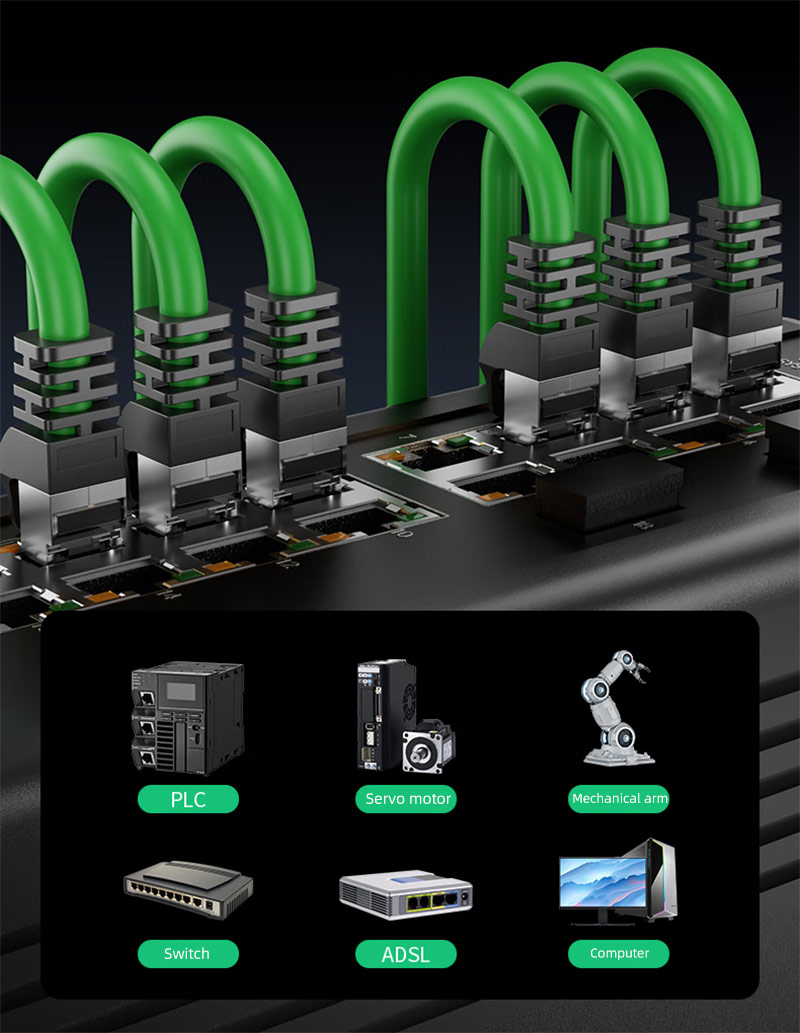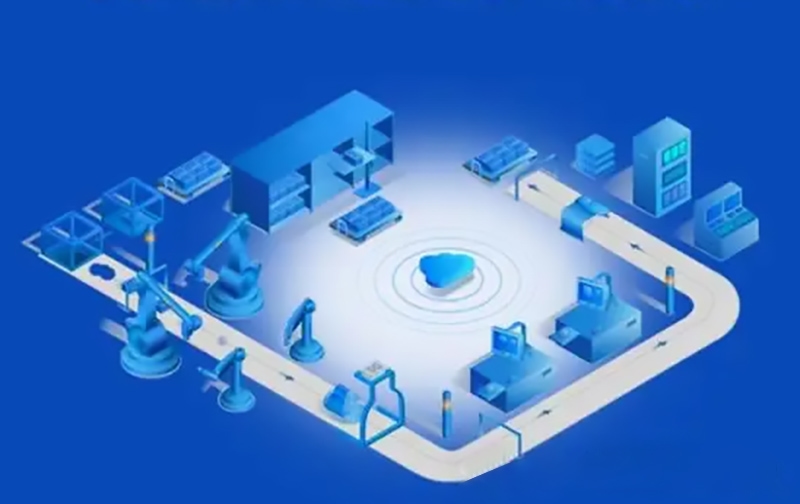Industrial Networking Cables Security in IIoT: Essential Threat Defense Strategies for Connected Manufacturing

Why Does Industrial Networking Cable Security Become Critical in IIoT Integration?
Attacks utilizing the physical layer completely circumvent all cybersecurity protections within a network, including firewalls, intrusion detection systems, and encryption, when they target cables directly. Industrial protocols, such as Modbus TCP and EtherNet/IP, send unencrypted data over ethernet cables, allowing physical layer attacks to happen, even with simple equipment that costs around $500, which can be adaptive with simple programming knowledge. A pharmaceutical facility identified unauthorized splices in cables during routine maintenance. The breach was undetected for several months and resulted in $2.1 million in regulatory fines and lost production time due to shutdowns. This points to significant financial and operational exposure present when cable infrastructure is not appropriately secured within a manufacturing-based environment.
What Makes Physical Cable Access the Weakest Security Link?
The inherent vulnerability rests in classifying cables as a passive infrastructure rather than active attack vehicles. Reliability is paramount in industrial protocols where control commands, process data, and safety signals are transmitted without encryption. Engineers design paths for convenience instead of resistance to an adversary, resulting in systematic exposure points throughout a manufacturing facility.
What Are the Core Vulnerabilities in High-Risk Physical Access Points?
Industrial ethernet infrastructure has systematic weak points at cable termination sites, junction boxes, and routing paths that are not designed to resist threat exposure but in consideration for maintenance convenience. These are direct access points to sensitive communications while presenting few technical barriers to the adversary.
Critical Exposure Points: Cable Cabinet, Conduits and Junction Boxes
Primary attack points available to opponents:
- Unlocked cable cabinets
- Unmonitored junction boxes
- Accessible cable trays hung from ceilings
- Unprotected locations (floor, wall) for conduit entry
- Cable runs into maintenance areas
Internal threats are particularly serious when legitimate credentials and knowledge of the facility are used to target specific cables that transfer sensitive data; external threats target these weak points in areas of simple access and minimal oversight, such as accessible cable trays mounted to ceilings while conducting routine maintenance.

Why Industrial Network Cable Security is Crucial in IIoT Integration
Signal Interception Against Unencrypted Industrial Protocols
Technical barriers are surprisingly few:
- Network taps cost less than $500 for professional-grade hardware and software.
- Basic analysis and network skills are sufficient to interpret protocols (e.g., Modbus).
- 15 minutes of time to install taps for those knowledgeable and experienced.
- Operation is completely undetectable to a normal organizational network monitoring packet analysis tools.
- Passive connections require no credential access or legitimate use of a network.
The high-impact consequences allow for significant impact on a company:
- Theft of proprietary formulations and manufacturing recipes worth a multi-million dollar segment.
- Production schedules can be displayed, allowing for competitive advantage in employee work expectations.
- Quality control parameters used to determine tolerances, quality, and specifications.
- Safety system communications used to notify an organization’s weaknesses to response.
- Command injection providing direct manipulation of known processes.
As an example of adversarial activity in the industrial sector, the beverage bottling industry reported attackers tapped cables from mixing systems to supervisory computers to intercept proprietary formulations.
How Do Environmental Factors Amplify Cable Security Risks?
Industrial environments present unique challenges that regular office protections do very little to address in terms of security. Temperature extremes cause cable conduits to expand and contract, which loosens protective seals and creates additional access points. Chemical exposure can dissolve adhesive seals and corrode metal components. Mechanical vibration from heavy machinery can also loosen cable connections and security fasteners. In extreme temperatures, your security equipment and devices may not operate reliably, even more so than your standard network components. In extreme cold storage facilities, locks may freeze, while in excessively hot environments, locks may expand beyond operational tolerances. Your electronic security systems may need additional environmental protection.
How Do Advanced Threats Execute Cable-Based Attacks Through Man-in-the-Middle (MitM) and Protocol Manipulation?
Sophisticated adversaries utilize physical cable access to execute man-in-the-middle operations and bypass network perimeter protections entirely. Once adversaries gain physical access, there is no need to worry about authentication, encryption obstacles, or detection by monitoring network activity. Physical access allows adversaries direct operational manipulation of the communications going in and out of critical control systems.
Man-In-The-Middle Execution: Cable Tapping Without Disrupting Communication Performance
In one case, a steel manufacturing facility experienced a sophisticated breach through access to blast furnace sensor cables that went undetected for six months. Attackers used portable network tap devices, slightly smaller than smartphones, to tap the cable signals without disrupting normal operations, maintaining signal integrity at both endpoints to avoid detection. After the attack was discovered, the investigation found that the attackers used the production data captured by the tap device to determine steel grade specifications and production schedules, enabling commodity trading strategies that generated millions in illegal profits. Sophisticated tap installations in situations such as this can run cables unexposed, taking advantage of the environmental conditions in utility corridors where multiple systems run parallel to one another, providing cover while giving access to high-value communications.

Industrial Network Cable Security in IIoT
Strategized Cable Splicing for Undetected Network Penetration
An automobile assembly plant discovered malicious cable alterations during a routine upgrade project; the investigation revealed that attackers had spliced into Ethernet connections serving robotic welding stations about six months earlier. In these situations, ARP spoofing through physical access has been demonstrated to be highly effective, as attackers can connect rogue machines into the trusted network segment. Once adversaries gain physical access to the network, session hijacking is trivial. Concealment strategies are established with the intentional goal of presenting the cable modifications as routine, typical alterations. Attackers often disguise the splicing as routine network connection components.
Why Industrial Control Command Injection Succeeds Through Physical Access?
When attackers can insert packets directly into cable segments with embedded control commands, protocol manipulation becomes simple, as there are no authentication mechanisms inherent in Ethernet-based protocols like Modbus TCP and EtherNet/IP that can prevent an attacker trying to insert commands. When attackers have physical access to a cable, they can bypass all layers of network security that would prevent a command injection attack. Through cable networks, horizontal movement is a logical process; by observing the traffic through a packet capture tool, attackers can map the network topology. The technical process involves a packet crafting tool that generates a valid sequence of commands, and a timing sync between the crafted packet and system states so that the commands execute during a specific condition of the system state.
What does the professional field assessment expose about your risks in cable infrastructure?
Professional security assessments reveal systematic issues that affect 78% of manufacturing facilities through testing that is not included in a standard IT audit. Field testing provides actionable risk assessment for the purpose of turning an abstract security risk into a concrete business case for an investment into protecting your infrastructure.
Professional cable infrastructure risk assessment procedures and tools
The vulnerability or risk assessment process begins with a complete mapping of the cable infrastructure, using cable tracing equipment and time-domain reflectometry to find unauthorized splices and possible points for interception. Then, risk assessment matrices will categorize the vulnerability based on how accessible the risk is, the risk context, and how difficult the risk is to detect. The assessment team will use portable network analysis equipment to recreate real-life attack scenarios without disruption to production environments. Penetration testing protocols will specifically target the industrial networking cable through a defined evaluation process; the assessment team will document the location of the vulnerabilities and prioritize recommendations for remediation based on risk assessment.
 Quantifying Prevention Costs vs Manufacturing Downtime Impact
Quantifying Prevention Costs vs Manufacturing Downtime Impact
An analysis of a pharmaceutical manufacturing operation found that implementing complete cable protection measures required an initial investment of $127,000 and annual costs of $18,000, and is much cheaper than the $45,000 per hour a company would incur in production loss. If a cyber attack against the factory were successful and focused on cable infrastructure weakness, the total recovery time was estimated between 72–96 hours. The estimated loss from the simulated rack attack ranged from $3.2–4.3 million.
An industry-specific return-on-investment analysis found:
- Pharmaceutical companies may achieve 420% ROI
- Automotive assembly operations may show 340% ROI
- Chemical processing sites may achieve 280% ROI
- Food and beverage manufacturers report 290% ROI
Penalties imposed by regulators could exceed the initial costs of incident response by 200–400%.
Most Common Cable Security Gaps in Manufacturing Facilities
Critical Infrastructure Vulnerabilities:
- Missing tamper-evident seals (94%)
- Unlocked electrical panels (89%)
- Severable zip ties (73%)
- Junction boxes not monitored (67%)
- Unsecured ceiling trays (52%)
- Lack of network separation (41%)
Environmental Protection Weaknesses:
- Loose cable entry seals (68%)
- Moisture damage (45%)
- Chemical damage (38%)
- Fasteners loosened from vibration (29%)
What Physical Defense Strategies Effectively Protect Industrial Cables?
To ensure cables are optimally protected, layered defensive strategies should be implemented. These strategies incorporate:
- physical access controls
- tampering detection
- environmental protections
Layered strategies are optimally applied to segments of cable that are higher risk, with a risk assessment on the strategic level for the overall level of protection based on effectiveness balanced with operations.
 Cable Routing and Access Controls
Cable Routing and Access Controls
A chemical processing plant reconfigured its cable routing system after finding numerous access points due to a lack of access controls, specifically more Ethernet cabling communicating directly with control systems rather than being separated. After embarking on this process, critical Ethernet connections were routed solely within secure conduits, separating control system traffic from general network traffic. This process eliminated 73% of access points previously identified as weak points. The level of system criticality on a predetermined scale prioritizes the strategy of cable separation. Strategies utilizing physical isolation create multiple blocks between the attacker and the physical cable infrastructure. Other integrations of monitoring systems orchestrate a constant surveillance layer, including access logging systems that track all interactions with secured cable infrastructure, creating an audit trail.
Tamper-Evident Technologies: Mechanical Locks vs Optical Reflection Monitoring
| Technology | Cost per Point | Detection Time | Bypass Difficulty | False Alarm Rate | Maintenance Cycle |
| Mechanical Locks | $45 | Manual (90s) | Low—specialized tools | N/A | 18 months |
| Physical Seals | $12 | Manual inspection | Variable by design | N/A | Single use only |
| Optical Monitoring | $340 | Automated (15s) | High—advanced expertise | 0.3% | 3+ years |
A power generation organization experienced several breaches to its security protocol, and besides using mechanical locking systems, the organization compared three different tamper-evident solutions for their overall value. Mechanical locking solutions demonstrated excellent deterrent value by providing visual indication that the locking mechanism was (still) engaged. However, these locks could be bypassed, using specialized tools to pry open the locks in 90 seconds or less. Physical seals offered even lower-cost solutions, but careful tampering, once stepped up, got around the locking mechanisms.
Visible and concealed optical reflection monitoring solutions provided real-time tamper detection with laser technology for detecting microscopic displacement in fiber optic cable positions with 99.7% accuracy. An optics-based system, over a three-year period, provided superior low total cost of ownership analysis, even if the capital outlay was higher than the locking systems.
Ways to Increase Security While Maintaining Operational Access
Tiered access control systems are designed to resolve any conflict through varying security levels that can be tied to the criticality of the cable and the desired frequency of maintenance. For example, emergency access protocols would indicate that security systems (locks) will never restrict access to maintenance through automated override protocols, and maintain a complete audit trail.
Focusing on limiting risk, security will allocate protection resources toward the most vulnerable and valuable portions of cable by utilizing stepped-up agreements on package security systems. This provides value by securing resource investments with flexibility for several operational functions.
 How Does Fiber Optic Architecture Provide Superior Security Over Copper Cables?
How Does Fiber Optic Architecture Provide Superior Security Over Copper Cables?
The light-transmitting nature of fiber optic technology removes electrical emanations that could allow an adversary to eavesdrop from a distance, no longer allowing communication on copper. Exposure to unauthorized surveillance using light is greatly diminished, and any unauthorized access or tampering of fiber optics is easily detectable when compared to copper installations.
Isolating Critical Zones with Fiber Optics
A nuclear power plant created complete isolation with fiber optics for the reactor’s control system, specifying designated optical paths that physically separated safety-critical communications from administrative networks. This created the equivalency of an air gap without compromising operational connectivity requirements. This baseline zone-based fiber deployment effectively creates concentric layers of security around high-value assets. An inner zone that carries emergency shutdown commands utilizes dedicated fiber pairs and is not connected externally; an intermediate zone utilizes additional fibers that are open but limited in gateway access points.
Physics: Why Fiber Optic Tapping Is Difficult
A semiconductor manufacturing facility found attempts to tap the copper communication lines, but not one attempt was made to gain access to the fiber optic installations associated with the operations of the clean room. The adversary abandoned their intentions to tap the fiber optic lines because they lacked the splicing equipment and skills needed to access the fiber. Tapping a fiber optically means that the attacker must align the optical beam and use expensive specialized equipment that costs tens of thousands of dollars. In order to tap a form of signal, physical access to the glass core must be achieved using tools designed for this purpose. Inserting a beam splitter for the signal extraction will represent some form of attenuation to the optical signal, and this will typically be detected by any optical monitoring or security system that may exist.
How Does OTDR Technology Enable Real-Time Fiber Security Monitoring?
OTDR systems offer industrial-quality cable monitoring with detection sensitivity of optical power changes down to 0.01 dB across cable spans as long as 40 kilometers. Such unauthorized splicing attempts yield computationally unique reflection signatures that automated monitoring systems quickly flag as security events in seconds. For industrial operational deployment, environmental compensation systems can also distinguish between actual security threats and legitimate operational behavior impacting optical signals—maintaining accuracy of detection upwards of 99.7% in highly active manufacturing environments.
How do Cable-Level Intrusion Detection Systems (C-IDS) work in practice?
Cable-level intrusion detection systems operate at the physical layer, detecting unauthorized access for industrial applications prior to the perpetrator completing the act. Successful C-IDS applications rely on calibrated settings; the system achieves efficiency and accuracy, performs environmental compensation, and is integrated into an existing security and safety infrastructure.
OTDR and Physical Signal Monitoring for Real-Time Detection of Tampering
Industrial C-IDS applications utilize monitoring signal anomalies that segment measurements to established baseline patterns. Installation complexity varies significantly based on cable infrastructure design and the length of the monitoring coverage area. Configuration arrangement parameters include pulse width settings, frequency intervals, and relevant thresholds for alarm.
C-IDS Performance in Industrial Applications: Balancing Accuracy and False Alarms
In a petrochemical refinery, a C-IDS achieved a detection accuracy of 96.8% during a twelve-month operational evaluation, detecting four intrusion attempts, with only twelve false alarms when standard maintenance activities were performed. In clean manufacturing facilities with stable environmental conditions, the monthly false alarm rate was below 0.5%. One facility with a C-IDS in a heavy industrial site experienced a monthly false alarm rate of 2.3%, although advanced environmental compensation algorithms were implemented. Advanced algorithms utilize machine learning capabilities that adapt to the unique environmental patterns specific to a facility.
Why Integration with Existing SCADA Systems Enhances C-IDS Effectiveness?
The integration of SCADA provides a multiplicative effect to the efficacy of C-IDS by correlating the established physical cable monitoring with operational system status information. Contextualized review allows for discrimination between the detection of actual physical security threats and system operational events, which drastically lowers the instances of false alarms and improves the reliability of detection around threats. Unified monitoring platforms create multi-layered frameworks for the review of alerts from C-IDS and correlate this information with other instrumented security systems such as the access control logs and video surveillance feeds, thus alleviating the burden on security personnel to filter true alerts.
 What Is the Complete Incident Response Playbook for Cable Security Breaches?
What Is the Complete Incident Response Playbook for Cable Security Breaches?
Cable security events require immediate and coordinated incident response actions that mitigate damage and create evidence for a full investigation and potential enforcement. Good incident response plans provide clear decision paths with protocols developed that allow security personnel to take incident response actions in a time-sensitive manner while under duress.
Foundation Stone 1: The Rapid Isolation Decision Tree – When and How To Implement Emergency Disconnection
In a pharmaceutical manufacturing facility, a cable tampering incident arose during production when it would cost $850,000 in batch loss when emergency disconnection needed to be considered. During a security assessment, it was found that data was being exfiltrated through the Ethernet cables the cyber adversary compromised, and active command injections were being sent to the safety systems. Emergency isolation protocols were triggered immediately, even though it would stop production. Emergency disconnection procedures established for the cable were first characterized by only emergency isolating affected cable segments from compromised electrical cables while maintaining connectivity to unaffected systems. The facility also planned for production continuity by ensuring backup communication systems were staged to activate in the event of isolating cables from access controls and computer networks.
Road Foundation Stone 2: Cable Forensics Evidence Preservation for the Legal Investigation
A digital forensics team discovered that complicated cable tapping devices were employed by an adversary that breached security protocols on a defense contractor project. These cable devices had been deployed unstopped for eight months and were collecting classified project communications via fiber optic splices. The chain of custody process begins immediately upon discovering compromised cable infrastructure. Forensic personnel photograph the compromised environment of the cable infrastructure prior to disturbing the physical evidence. This evidence may include documentation that details information about the device’s physical location and situational awareness specific to the device itself. Ultimately, fact-finding outcomes of the investigation and situational management depend on the penalizing agency and outcome follow-ups, which eventually result in evidence considerations of someone tampering with and traversing communication risks between the cable adopting/implementing isow strategies.
Road Foundation Stone 3: Fast Recovery after Cable Incident Compromise (Do Not Forget Evidence Preservation)
Recovery sequencing typically prioritizes systems that carry a higher operational value and safety. Immediate attention should be paid to the recovery of safety systems, even if they may be more technical and complicated. After which, focus on systems that have production value, then the use of communications regardless of administrative systems. The emergency disconnection procedures utilize backup communication by initializing new redundant communication pathways where the investigated and compromised cabling was removed and converted to operational systems. Lastly, once recovery processes are restored, recovery verification protocols must demonstrate the restoration of cable infrastructure that is returned safely, securely, and meets specifications for performance. The level of performance and operational need must also be verified.
How to Establish Sustainable Cable Security Through Continuous Audit and Monitoring?
To achieve sustainable cable security, you must have a systematic approach that sustains a protection level over time without negatively impacting operational efficiency. Your ability to sustain your protection level over time will depend on merging audit processes, ongoing automated monitoring systems, and complete staff training programs.
Essential Cable Security Audit Checklist for Manufacturing Compliance
An aerospace manufacturing facility identified several critical deficiencies through scheduled quarterly cable security audits that standard IT audits did not identify. When an audit process was normed, the cable security protocol indicated:
- 34% of ethernet cable termination points were missing tamper-evident seals, and
- 18% of junction boxes had visible indications of tampering.
These vulnerabilities, as described in the audit process, can be summarized as follows:
Critical Infrastructure Vulnerabilities:
- Missing Tamper-Evident Seals (94%)
- Unlocked Electrical Panels (89%)
- Severable Plastic Fasteners (73%)
- Unmonitored Junction Boxes (67%)
- Unsecured Access Points in Ceiling Space (52%)
- Inadequate Separation from Network Connections (41%)
Periodic audit processes vary based on the risk profile of the facility and mandated regulatory mandates. The physical inspection protocol of cable security audits is intended to examine cable route integrity, enclosure security, and environmental protection effectiveness.
Continuous Monitoring Systems: Overall Architecture and Alert Management
A chemical processing plant successfully employed a layered monitoring architectural system that resulted in an 89% reduction in cable security events over two years of operations. This integrated physical sensors, remote monitoring of network traffic, and environmental monitoring technology to create comprehensive information coverage. Multi-tier deployment strategies establish a depth of monitoring reflecting cable criticality and exposure to perceived threats. Environmental sensor systems are capable of detecting physical intrusion attempts by the perpetrator before they complete their operational directive. The intelligent algorithms driving the alerting system are able to manage false positives by applying pattern recognition and environmental correlation to ascertain accuracy.
Why Regular Security Training Enhances Physical Cable Protection?
Human factors are essential components in the efficacy of cable security due to personnel behavior directly impacting physical protection system effectiveness. Untrained personnel can unintentionally position security in jeopardy by failing to follow established processes or are simply unaware of potential threat indicators. The effectiveness of training will multiply when the training program and security concepts are action-based and pertain to the specific job function being performed at a particular time instead of generic security concepts. Development of competencies establishes quantifiable standards for skill levels and then assesses them for the position. Performance metrics are there to gauge and assess outcomes for training effectiveness based on incident reduction rates, audit compliance scores, and personnel competency assessment checklists.

 Quantifying Prevention Costs vs Manufacturing Downtime Impact
Quantifying Prevention Costs vs Manufacturing Downtime Impact Cable Routing and Access Controls
Cable Routing and Access Controls How Does Fiber Optic Architecture Provide Superior Security Over Copper Cables?
How Does Fiber Optic Architecture Provide Superior Security Over Copper Cables? What Is the Complete Incident Response Playbook for Cable Security Breaches?
What Is the Complete Incident Response Playbook for Cable Security Breaches?